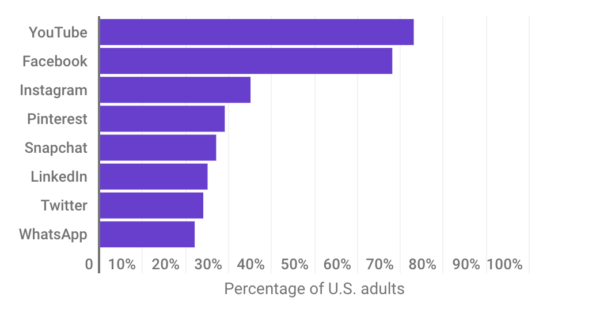Aug 9, 2018
The Stash Guide to Investing in Social Media Stocks
Snap, Tweet, Like: This guide to the business of social media is good enough to share.

Post! Like! Share! Tweet! The business of social media is all around us, changing the way we tell stories, break news, and interact with our friends and family.
Despite much of it being less than a decade old, social media technology is now deeply embedded in our culture. These days, everyone from celebrities, athletes, and politicians use social media to make announcements to the wider world. President Trump famously uses Twitter to express his views and announce policy changes. Stars such as Kanye West and Kylie Jenner also regularly take to social media to raise awareness of their brands and to sound off on whatever they’re thinking that day.
In August, Tesla CEO Elon Musk caused a brief shutdown in trading of the company’s shares when he announced via Twitter that he was thinking of taking his company private.
It’s not just the rich and powerful, either. Today, thanks to sites like Facebook, Snapchat, Instagram and Twitter it seems like everyone has a bullhorn to express themselves in real time.
Although social media is still in its adolescence, it continues to reshape the world and how we relate to each other as humans.
Here’s a quick guide to help you understand the industry and where it’s going.
What is the social media industry?
Today, 70% of Americans use social media in one form or another, whereas in 2005, only 5% did, according to industry data. Worldwide, there are roughly 3.2 billion social media users–and that number is growing, according to research.
That’s pretty impressive, considering the industry barely existed 20 years ago.
In the early days, during the late 1990s and early 2000s, the industry consisted of companies such as LiveJournal, Friendster, and Myspace. Those early social pioneers had struck gold when discovering this new market, though they didn’t quite have their mining techniques developed yet. While none of these companies is around today, they were onto something. Namely, people want to connect, share stories, and see their friends online.
LinkedIn launched in 2003 with a career-oriented spin to social networking. Facebook was founded in 2004, and as we all know, went on to conquer and shape the social networking space as it exists today.
While there have been dozens, if not hundreds of social media companies founded over the years, only a handful have survived; And even those have evolved beyond their original intentions.
Facebook, for example, started as little more than an online phone book for Harvard students. Today, it’s the third-biggest social media platform on the internet.
Which companies are dominating the social media industry?
In the last decade, social networks migrated to smartphones–and have gone international.
There are numerous competing social networks, largely unknown in the U.S., that have billions of users in China, Russia, and India. Examples include QQ, Weibo, and WeChat (China), VKontakte (Russia), and Taringa (South and Central America).
Here are the biggest social networking companies in the U.S. by the number of users, and the percentage of adults who use them, according to data from Pew Research Center:

Source: Pew Research Center
Numerous other popular platforms exist today that feature social networking to one degree or another, allowing users to interact broadcast, and develop followings. They run the gamut from Reddit to Quora, and Tumblr to popular kids’ social media video app HouseParty.
Turning “likes” into dollars
The biggest issue early social networking companies faced was how to make money from people’s desire to connect online.
Some companies figured out the magic recipe was largely based on advertising. Facebook has created an enormous digital advertising platform, allowing paid advertisements and sponsored content to pop up into users’ feeds. LinkedIn, on the other hand, earns revenue by offering a variety of paid, premium services to users, and by charging recruiters and HR teams looking for talent.
Advertising, though, is the primary way social media companies generate revenue. These companies have oceans of data about their users, which they can supply to companies looking to advertise. Companies are willing to pay for the data because it targets specific demographics and buying behavior.
How much does this earn a social media company? During the fourth-quarter of 2017, Facebook reportedly made $6.18 per user, mostly through advertising. Snapchat made $1.53 per user during the same time period.
What’s next for the social media industry?
The industry has grown and evolved rapidly, and it’s very likely here to stay. But there are several critical issues the sector grapples with.
First, there’s the specter of increased government regulation. Following the 2016 presidential election, in which social media played a pivotal role through political advertising and messaging, companies including Facebook and Twitter have come under intense scrutiny, as their platforms were used to disseminate often false or misleading misinformation.
Facebook, in particular, has faced investor and regulatory wrath for giving away data of nearly 90 million users to the political consulting firm Cambridge Analytica.
Calls for regulation
The U.S. government has yet to step in and lay down a new legal framework regarding social media and customer privacy, but lawmakers in Congress continue to discuss it. Meanwhile, new privacy legislation has passed swiftly in other countries, like those in the European Union.
Second, social media companies have started to morph into media companies of their own, with the power to disseminate information and content to billions of people around the globe. Instagram and Snapchat Stories allow users to make mini-movies about their daily lives. In 2018, Facebook launched its own Netflix rival, Facebook Watch.
And as talk about potential regulation heats up, so to have suggestions that platforms like Twitter or Facebook should follow the same rules as traditional media companies.
That could force them to adhere to regulations of the Federal Communications Commission (FCC), similar to TV and radio broadcasters, among other things.
Finally, signs have emerged that industry growth may be experiencing a slowdown in demand for the traditional social media offering–networking.
Recent earnings reports by Facebook and Snap, for example revealed that user growth is decreasing after years of gains.
A changing business
In order to keep growing, some social networks have expanded beyond their traditional platforms. In some cases, that means that they’ve acquired rivals. For example, Yahoo bought Tumblr, Google gobbled up YouTube, and Facebook purchased Instagram as well as the multi-platform messaging app WhatsApp. There have also been rumors about Facebook, Google, or even Amazon–a company that currently has very little presence in social networking–attempting to buy Twitter.
Some companies are growing beyond the social networking industry altogether in an effort to continue developing and engaging audiences. In 2014, Facebook purchased virtual reality company Oculus to expand into VR, for example, and in 2015, LinkedIn bought online learning company Lynda to offer its users online business and marketing classes, and software tutorials.
Twitter, too, branched out by acquiring a social media talent agency that finds and develops personalities that create content specifically tailored to the platform.
But even as the industry matures, it’s expected to continue growing and evolving. As with every industry, though, things can change.
When it comes to social media companies, you can make some acquisitions of your own. Check out social media single stocks and ETFs on Stash–all it takes is $5 to get started.
Related Articles

15 Largest AI Companies in 2024

The 12 Largest Cannabis Companies in 2024

What Is a Traditional IRA?

Saving vs. Investing: 2 Ways to Reach Your Financial Goals

How To Invest in the S&P 500: A Beginner’s Guide for 2024

Stock Market Holidays 2024





